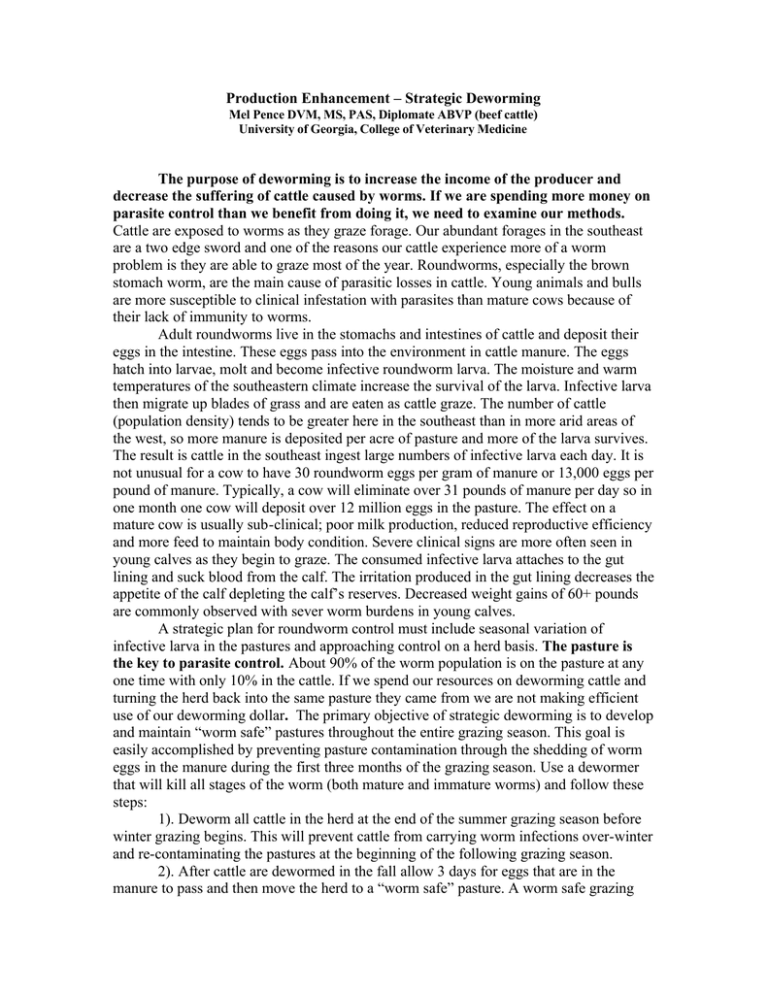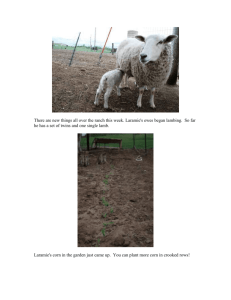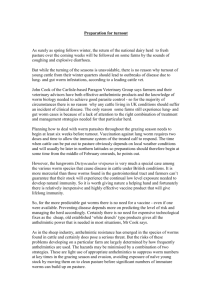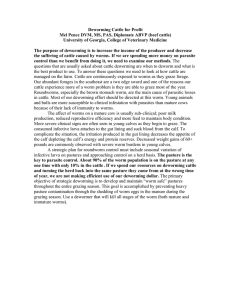Production Enhancement – Strategic Deworming
advertisement

Production Enhancement – Strategic Deworming Mel Pence DVM, MS, PAS, Diplomate ABVP (beef cattle) University of Georgia, College of Veterinary Medicine The purpose of deworming is to increase the income of the producer and decrease the suffering of cattle caused by worms. If we are spending more money on parasite control than we benefit from doing it, we need to examine our methods. Cattle are exposed to worms as they graze forage. Our abundant forages in the southeast are a two edge sword and one of the reasons our cattle experience more of a worm problem is they are able to graze most of the year. Roundworms, especially the brown stomach worm, are the main cause of parasitic losses in cattle. Young animals and bulls are more susceptible to clinical infestation with parasites than mature cows because of their lack of immunity to worms. Adult roundworms live in the stomachs and intestines of cattle and deposit their eggs in the intestine. These eggs pass into the environment in cattle manure. The eggs hatch into larvae, molt and become infective roundworm larva. The moisture and warm temperatures of the southeastern climate increase the survival of the larva. Infective larva then migrate up blades of grass and are eaten as cattle graze. The number of cattle (population density) tends to be greater here in the southeast than in more arid areas of the west, so more manure is deposited per acre of pasture and more of the larva survives. The result is cattle in the southeast ingest large numbers of infective larva each day. It is not unusual for a cow to have 30 roundworm eggs per gram of manure or 13,000 eggs per pound of manure. Typically, a cow will eliminate over 31 pounds of manure per day so in one month one cow will deposit over 12 million eggs in the pasture. The effect on a mature cow is usually sub-clinical; poor milk production, reduced reproductive efficiency and more feed to maintain body condition. Severe clinical signs are more often seen in young calves as they begin to graze. The consumed infective larva attaches to the gut lining and suck blood from the calf. The irritation produced in the gut lining decreases the appetite of the calf depleting the calf’s reserves. Decreased weight gains of 60+ pounds are commonly observed with sever worm burdens in young calves. A strategic plan for roundworm control must include seasonal variation of infective larva in the pastures and approaching control on a herd basis. The pasture is the key to parasite control. About 90% of the worm population is on the pasture at any one time with only 10% in the cattle. If we spend our resources on deworming cattle and turning the herd back into the same pasture they came from we are not making efficient use of our deworming dollar. The primary objective of strategic deworming is to develop and maintain “worm safe” pastures throughout the entire grazing season. This goal is easily accomplished by preventing pasture contamination through the shedding of worm eggs in the manure during the first three months of the grazing season. Use a dewormer that will kill all stages of the worm (both mature and immature worms) and follow these steps: 1). Deworm all cattle in the herd at the end of the summer grazing season before winter grazing begins. This will prevent cattle from carrying worm infections over-winter and re-contaminating the pastures at the beginning of the following grazing season. 2). After cattle are dewormed in the fall allow 3 days for eggs that are in the manure to pass and then move the herd to a “worm safe” pasture. A worm safe grazing area is one that has not had cattle on it for several months. Rye grass seeded in a row crop field like peanut ground, hay ground that has not been grazed all summer, corn stocks, mowed cotton or harvested peanut ground are examples of worm safe grazing. 3). Worm all cattle in the herd about March 20th in south Georgia and about April st 1 in north Georgia with a wormer that gets all stages of worms. Worms have the ability to over-winter in a pasture. About March 1 in South Georgia and March 15 in North Georgia worms that have over-wintered in pasture begin to form infective larva and are consumed by grazing cattle. It takes about three to four weeks before these ingested larva mature and begin to lay eggs. Deworming just prior to egg shedding will decrease pasture worm contamination. 4). Heavily contaminated pastures may require a second spring deworming three to four weeks after the initial spring deworming. So a minimal strategic deworming program requires two dewormings of the entire herd each year, one of them three days before going to a worm safe winter grazing and one between March 20 and April 1 depending on the area of Georgia you are located. With the quality of deworming products we have at our disposal today, we can reduce the economic losses due to cattle parasites and do it cost effectively. We need to have a strategic plan that controls worms in the cattle and worms on the pasture. Your local veterinarian, county extension agent or one of us would be glad to assist you in developing a strategic deworming program specific to your location and operation.






